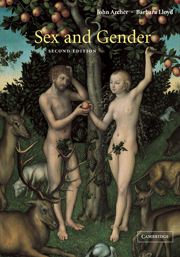Book contents
- Frontmatter
- Contents
- List of figures
- List of tables
- Preface
- 1 Commonsense beliefs and psychological research strategies
- 2 Stereotypes, attitudes, and personal attributes
- 3 Origins
- 4 Developmental influences
- 5 Sexuality: psychophysiology, psychoanalysis, and social construction
- 6 Aggression, violence, and power
- 7 Fear, anxiety, and mental health
- 8 The domestic sphere
- 9 Work, education, and occupational achievement
- 10 Looking back and looking ahead
- References
- Index
2 - Stereotypes, attitudes, and personal attributes
Published online by Cambridge University Press: 11 May 2012
- Frontmatter
- Contents
- List of figures
- List of tables
- Preface
- 1 Commonsense beliefs and psychological research strategies
- 2 Stereotypes, attitudes, and personal attributes
- 3 Origins
- 4 Developmental influences
- 5 Sexuality: psychophysiology, psychoanalysis, and social construction
- 6 Aggression, violence, and power
- 7 Fear, anxiety, and mental health
- 8 The domestic sphere
- 9 Work, education, and occupational achievement
- 10 Looking back and looking ahead
- References
- Index
Summary
Introduction
Stereotypes are the shared beliefs that people hold about a group of people such as an ethnic group, or people in a particular occupation. Gender stereotypes refer to the beliefs people hold about members of the categories man or woman. They can be viewed as elaborations of the commonsense notions we considered in chapter 1. In this chapter, we examine first the content of gender stereotypes – which attributes people commonly associate with men or women. We then discuss explanations of the stereotypes, principally whether they are exaggerations of reality, or whether they serve to justify social positions and prejudice.
We also consider attitudes to women and men. Attitudes are broader than stereotypes, in that they encompass feelings and intentions to act, as well as beliefs and thoughts, and they can apply not only to categories of people but to issues and events. Attitudes are identified when the three interrelated components are formed around particular persons, such as rock stars, or ethnic groups, or to a type of food, or to a political issue such as capital punishment. When people hold attitudes about a social group, the belief or cognitive component of their attitudes is equivalent to their stereotypic beliefs about that group. Attitudes about men and women also include feelings about them, whether they are liked or disliked. We examine measures of attitudes towards women and men, which generally indicate that people have a more positive view of women than of men.
- Type
- Chapter
- Information
- Sex and Gender , pp. 19 - 38Publisher: Cambridge University PressPrint publication year: 2002



